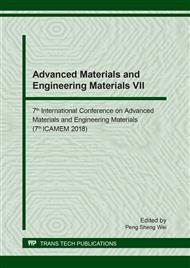[1]
Xianmao Lu, Younan Xia, Electronic materials: Buckling down for flexible electronics, Nature Nanotechnology. 1(3) (2006) 163-164.
Google Scholar
[2]
Rogers John A, Huang Yonggang, A curvy, stretchy future for electronics, Proceedings of the National Academy of Sciences of the United States of America. 106(27) (2009) 10875-10876.
DOI: 10.1073/pnas.0905723106
Google Scholar
[3]
Nishide H, Oyaizu K, Toward Flexible Batteries, Science. 319 (2008) 737-738.
DOI: 10.1126/science.1151831
Google Scholar
[4]
Li Li Zhang and X. S. Zhao, Carbon-based materials as supercapacitor electrodes, Chem. Soc.Rev. 38 (2009) 2520-2531.
Google Scholar
[5]
Miller J R, Simon P, Electrochemical Capacitors for Energy Management, Science. 321 (2008) 651-652.
Google Scholar
[6]
Simon P, Gogotsi Y, Materials for electrochemical capacitors, Nature Materials. 7(11) (2008) 845-854.
DOI: 10.1038/nmat2297
Google Scholar
[7]
Zhixin Tai, Xingbin Yan, Junwei Lang, Enhancement of capacitance performance of flexible carbon nanofiber paper by adding graphene nanosheets, Journal of Power Sources. 199(1) (2012) 373-378.
DOI: 10.1016/j.jpowsour.2011.10.009
Google Scholar
[8]
Yong Zhang, Hui Feng, Xingbing Wu, Progress of electrochemical capacitor electrode materials: A review, International Journal of Hydrogen Energy. 34(11) (2009) 4889-4899.
DOI: 10.1016/j.ijhydene.2009.04.005
Google Scholar
[9]
Reddy A L M, Amitha F E, Jafri I, Asymmetric Flexible Supercapacitor Stack, Nanoscale Research Letters. 3(4) (2008) 145-151.
DOI: 10.1007/s11671-008-9127-3
Google Scholar
[10]
Shengwen Zhang, Chuang Peng, Ng KC, Nanocomposites of manganese oxides and carbon nanotubes for aqueous supercapacitor stacks, Electrochimica Acta. 55(25) (2010) 7447-7453.
DOI: 10.1016/j.electacta.2010.01.078
Google Scholar
[11]
Graeme A.Snook, PonKao, Adam S.Best, Conducting-polymer-based supercapacitor devices and electrodes, Journal of Power Sources. 196(1) (2011) 1-12.
DOI: 10.1016/j.jpowsour.2010.06.084
Google Scholar
[12]
Weifeng Wei, Xinwei Cui, Weixing Chen and Douglas G. Ivey, Manganese oxide-based materials as electrochemical supercapacitor electrodes, Chem. Soc. Rev. 40 (2011) 1697-1721.
DOI: 10.1039/c0cs00127a
Google Scholar
[13]
Chia Ying Lee, Huei Mei Tsai, Huey Jan Chuang, Seu Yi Li, Pang Lin and Tseung Yuen Tseng, Characteristics and Electrochemical Performance of Supercapacitors with Manganese Oxide-Carbon Nanotube Nanocomposite Electrodes, J. Electrochem. Soc. 152(4) (2005).
DOI: 10.1149/1.1870793
Google Scholar
[14]
Chung Jung Hung, Jeng Han Hung, Pang Lin and Tseung Yuen Tseng, Electrophoretic Fabrication and Characterizations of Manganese Oxide/Carbon Nanotube Nanocomposite Pseudocapacitors, J. Electrochem. Soc. 158(8) (2011) A942-A947.
DOI: 10.1149/1.3601862
Google Scholar
[15]
Yiqing Sun, Qiong Wu and Gaoquan Shi, Graphene based new energy materials, Energy Environ. Sci. 4 (2011) 1113-1132.
Google Scholar
[16]
Cottineau T, Toupin M, Delahaye T, Nanostructured transition metal oxides for aqueous hybrid electrochemical supercapacitors, Applied Physics A. 82(4) (2006) 599-606.
DOI: 10.1007/s00339-005-3401-3
Google Scholar
[17]
Yingwen Cheng, Songtao Lu, Hongbo Zhang, Chakrapani V. Varanasi, and Jie Liu, Synergistic Effects from Graphene and Carbon Nanotubes Enable Flexible and Robust Electrodes for High-Performance Supercapacitors, Nano Lett. 12 (8) (2012) 4206-4211.
DOI: 10.1021/nl301804c
Google Scholar
[18]
Xuan Wang, Linjie Zhi, and Klaus Müllen, Transparent, Conductive Graphene Electrodes for Dye-Sensitized Solar Cells, Nano Lett. 8 (1) (2008) 323-327.
DOI: 10.1021/nl072838r
Google Scholar
[19]
Yan Wang, Yingpeng Wu, Yi Huang, Fan Zhang, Xi Yang, Yanfeng Ma, and Yongsheng Chen, Preventing Graphene Sheets from Restacking for High-Capacitance Performance, J. Phys. Chem. C. 115 (46) (2011) 23192-23197.
DOI: 10.1021/jp206444e
Google Scholar
[20]
Chung Jung Hung, Pang Lin, Tseung Yuen Tseng, Electrophoretic fabrication and pseudocapacitive properties of graphene/manganese oxide/carbon nanotube nanocomposites, Journal of Power Sources. 243 (2013) 594-602.
DOI: 10.1016/j.jpowsour.2013.06.055
Google Scholar
[21]
Zhuangjun Fan,Jun Yan,Linjie Zhi,Qiang Zhang,Tong Wei,Jing Feng,Milin Zhang, Weizhong Qian,Fei Wei, A Three‐Dimensional Carbon Nanotube/Graphene Sandwich and Its Application as Electrode in Supercapacitors, Advanced Materials. 22 (2010).
DOI: 10.1002/adma.201001029
Google Scholar
[22]
Wei Wang,Shi rui Guo,Miroslav Penchev, Isaac Ruiz, Krassimir N.Bozhilov, DongYan, MihrimahOzkan, Cengiz S.Ozkan, Three dimensional few layer graphene and carbon nanotube foam architectures for high fidelity supercapacitors, Nano Energy. 2(2) (2013).
DOI: 10.1016/j.nanoen.2012.10.001
Google Scholar
[23]
Zheng Yan, Lulu Ma, Yu Zhu, Indranil Lahiri, Myung Gwan Hahm, Zheng Liu, Three-Dimensional Metal-Graphene-Nanotube Multifunctional Hybrid Materials, ACS Nano. 7 (1) (2013) 58-64.
DOI: 10.1021/nn3015882
Google Scholar
[24]
Zhibin Lei, Fuhua Shi, and Li Lu, Incorporation of MnO2-Coated Carbon Nanotubes between Graphene Sheets as Supercapacitor Electrode, ACS Appl. Mater. Interfaces. 4 (2) (2012) 1058-1064.
DOI: 10.1021/am2016848
Google Scholar
[25]
Hummers W. S., OffemanR. E., Preparation of graphitic oxide, Journal of American Chemical Society. 80 (1958) 1339-1339.
DOI: 10.1021/ja01539a017
Google Scholar
[26]
Daniela C. Marcano, Dmitry V. Kosynkin, Jacob M. Berlin, Alexander Sinitskii, Improved Synthesis of Graphene Oxide, ACS Nano. 4(8) (2010) 4806-4814.
DOI: 10.1021/nn1006368
Google Scholar
[27]
Brousse T., Toupin M., Dugas R., Athoue ¨l L., Crosnier O., Be ´langer D, Crystalline MnO2 as Possible Alternatives to Amorphous Compounds in Electrochemical Supercapacitors, Journal of The Electrochemical Society.153 (2006) A2171-A2180.
DOI: 10.1149/1.2352197
Google Scholar
[28]
Shinomiya T, Gupta V, Miura N, Effects of electrochemical-deposition method and microstructure on the capacitive characteristics of nano-sized manganese oxide, Electrochimica Acta. 51(21) (2006) 4412-4419.
DOI: 10.1016/j.electacta.2005.12.025
Google Scholar
[29]
Beaudrouet E, Salle A L G L, Guyomard D, Nanostructured manganese dioxides: Synthesis and properties as supercapacitor electrode materials, Electrochimica Acta. 54(4) (2009) 1240-1248.
DOI: 10.1016/j.electacta.2008.08.072
Google Scholar
[30]
Liu H, Zhang W, Song H, Tremella-like graphene/polyaniline spherical electrode material for supercapacitors, Electrochimica Acta. 146(2014) 511-517.
DOI: 10.1016/j.electacta.2014.09.083
Google Scholar
[31]
Reddy A L M, Shaijumon M M, Gowda S R, Multisegmented Au-MnO2/Carbon Nanotube Hybrid Coaxial Arrays for High-Power Supercapacitor Applications, Journal of Physical Chemistry C. 117(42) (2010) 658-663.
DOI: 10.1021/jp908739q
Google Scholar


